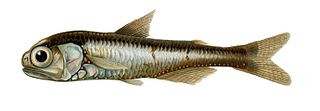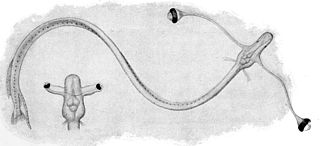The Chiroteuthidae are a family of deep-sea squid, generally small to medium in size, rather soft and gelatinous, and slow moving. They are found in most temperate and tropical oceans, but are known primarily from the North Atlantic, North Pacific, and Indo-Pacific. The family is represented by approximately 12 species and four subspecies in four genera, two of which are monotypic. They are sometimes known collectively as whip-lash squid, but this common name is also applied to the Mastigoteuthidae, which are sometimes treated as a subfamily (Mastigoteuthinae) of Chiroteuthidae.

The Enoploteuthidea are a family of squid comprising approximately 40 species in four genera. Most species have a mantle length ranging from 3–13 cm. Hooks are present on all arms and tentacles. The family is best known for the large array of photophores throughout the body.

Yehudi lights are lamps of automatically controlled brightness placed on the front and leading edges of an aircraft to raise the aircraft's luminance to the average brightness of the sky, a form of active camouflage using counter-illumination. They were designed to camouflage the aircraft by preventing it from appearing as a dark object against the sky.

Lanternfish are small mesopelagic fish of the large family Myctophidae. One of two families in the order Myctophiformes, the Myctophidae are represented by 246 species in 33 genera, and are found in oceans worldwide. Lanternfishes are aptly named after their conspicuous use of bioluminescence. Their sister family, the Neoscopelidae, are much fewer in number but superficially very similar; at least one neoscopelid shares the common name "lanternfish": the large-scaled lantern fish, Neoscopelus macrolepidotus.

Abralia is a genus of squid comprising around 20 species from the family Enoploteuthidae. They are small squid which can be found in the epipelagic to mesopelagic zones while some species are found in water with shallow substrates on steep slopes on the boundary of the mesopelagic zone. They are distinguished from other members of the Enoploteuthidae by not normally having large, black photophores at the tips of arms IV, although if these are present they are not covered in black chromatophores, and having fins which extend beyond their tail. The photophores of the integument are characteristicand are found in the three types. "Lensed" photophores are a blue color with a white ring, "simple" photophores are small and violet-colored and the "complex" photophores are surrounded by small green satellite points and have a green centre. The complex photophores will frequently appear to be blue depending on their physiological state. The integument also has small black chromatophores which look like dots. They have 5-12 variably sized photophores on the eye. Either the right or left arm IV is hectocotylized.

Symbolophorus is a genus of lanternfishes. It feeds on various small forms of sea life, in particular fish. Some species in this genus are known to exhibit the Stylophthalmine trait in their larval form

Symbolophorus barnardi is a lanternfish in the family Myctophidae, found circumglobally in the southern hemisphere between about 30° S and 11° S at depths of between 100 and 800 m. Its length is about 12 cm. It inhabits the deeper waters during the day, and migrates at night to the epipelagic zone.

Chiroteuthis veranii, commonly known as the long-armed squid, is a species of chiroteuthid squid. It grows to a mantle length of 12.5 cm and a total length of 130 cm.

Chiroteuthis is a genus of chiroteuthid squid, comprising two subgenera. The hectocotylus is absent from all members of the genus; instead, a penis extending from the mantle opening is utilised. The genus is characterised by enlarged, lidded photophores present at the end of the tentacular club. Arms IV are both the longest and thickest, their membranes acting as sheaths to the retractable tentacles.

Chevalier Jean Baptiste Vérany was a French pharmacist and naturalist who specialised in the study of cephalopods.

Counter-illumination is a method of active camouflage seen in marine animals such as firefly squid and midshipman fish, and in military prototypes, producing light to match their backgrounds in both brightness and wavelength.
Long-armed squid may refer to various long-limbed squid of the suborder Oegopsina:

Stylophthalmus was a name used for what was previously believed to be a genus of fish with eyes perched upon periscopic stalks, known in some cases to be almost one third of the length of the animal's actual body. It is now recognised that all species in this genus are the fish larvae of already named, distantly related fish in the orders Stomiiformes and Myctophiformes which may have developed this same trait as a result of convergent evolution. Thus, Stylophthalmus is an invalid name.

The Stylophthalmine trait is an adaptation present in the larvae of several different species of actinopterygian fish. It is characterised by the development of elliptically shaped eyes, which are situated at the apex of long periscopic stalks extending from the larva's head. Stylophthalmine can be used as a general term to describe such larvae.

Peniculus is a genus of marine copepods in the family Pennellidae. They occur worldwide and typically parasitize coastal or epipelagic fish, with the exception of Peniculus hokutoae that was found parasitizing a mesopelagic myctophid, Symbolophorus evermanni.

Peniculus hokutoae is a species of parasitic pennellid copepod. It was described in 2018 from a single female. The type-host is the myctophid fish Symbolophorus evermanni and the type-locality is off Japan. The Japanese name of this species is hokuto-kozutsu-hijikimushi.
Symbolophorus boops is a species of fish in the family Myctophidae.
Symbolophorus californiensis is a species of fish in the family Myctophidae.
Symbolophorus kreffti is a species of fish in the family Myctophidae.
Symbolophorus rufinus is a species of fish in the family Myctophidae.










